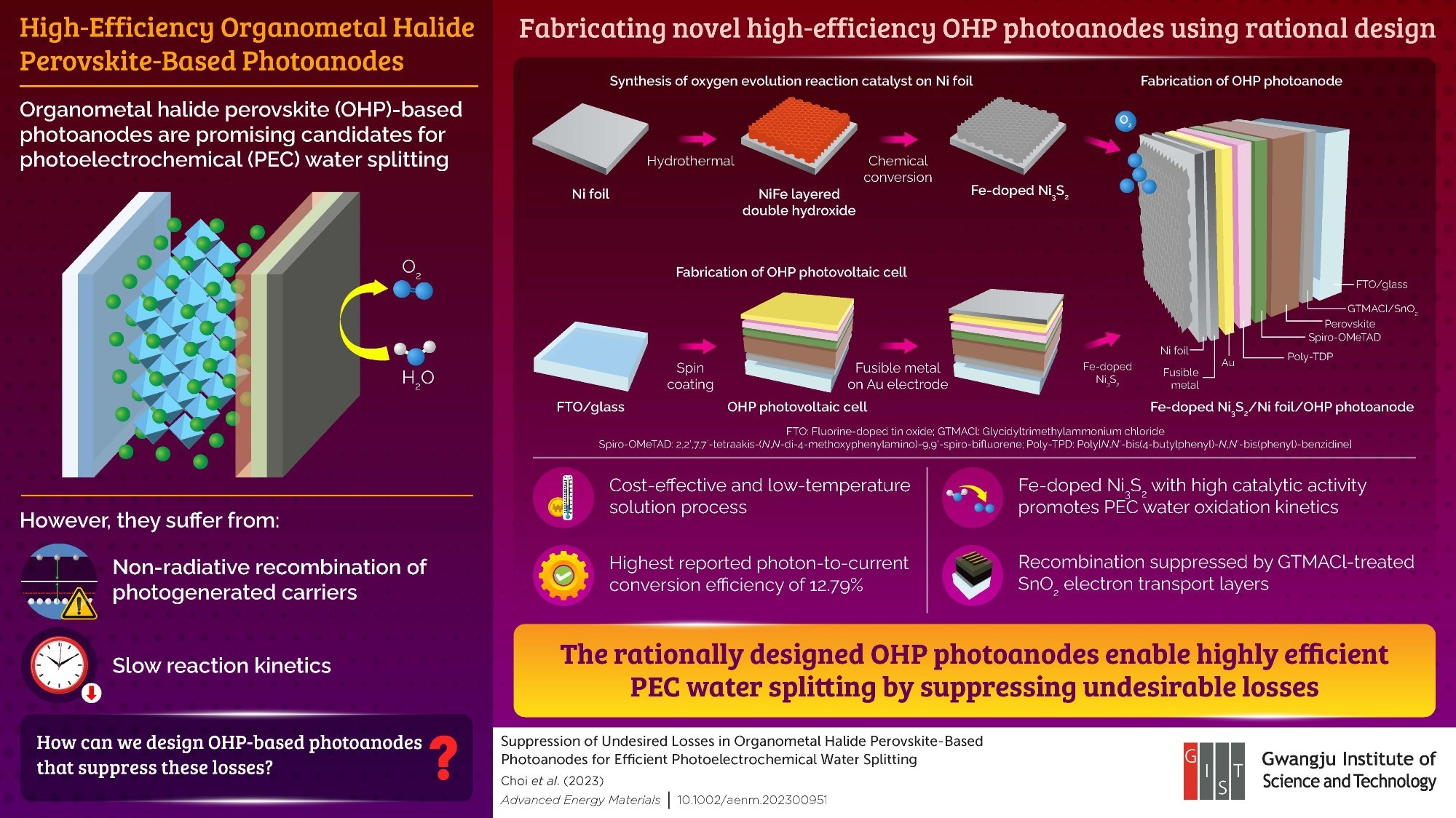Organometal halide perovskites (OHPs) have the potential to be used as photoanodes in photoelectrochemical water splitting to produce hydrogen. However, their effectiveness is constrained by slow reaction times and the recombination-induced loss of photogenerated charge carriers.

The novel photoanodes suppress the undesirable internal and external losses associated with photoelectrochemical water splitting, resulting in an unprecedented photon-to-current conversion efficiency of 12.79%. Image Credit: Professor Sanghan Lee from Gwangju Institute of Science and Technology, Korea
Now, scientists from Korea and the USA have created OHP-based photoanodes that are incredibly effective, thanks to a method based on rational design. These photoanodes have never before seen catalytic activity or light-to-current conversion efficiency like this.
Currently, hydrogen is primarily produced by natural gas, which produces greenhouse gases like carbon dioxide as a byproduct. Scientists argue that while this method of producing hydrogen is cost-effective, it is not truly sustainable and thus requires a more environmentally friendly method of production.
One such promising approach is solar-powered photoelectrochemical (PEC) water splitting. However, its widespread use is hampered by a scarcity of efficient photoanodes for catalyzing the rate-limiting oxygen evolution reaction (OER), which is a vital step in PEC water splitting.
Organometal halide perovskites (OHPs) have recently emerged as a potential photoanode material on this front. However, OHP-based photoanodes suffer from two undesirable losses that limit their efficiency. One is an internal loss caused by the recombination of photogenerated charge carriers (needed for electricity generation) within the anode itself, which impedes water splitting. The other is external loss caused by the slow reaction kinetics of water splitting, which results in a loss of charge carriers at the anode/electrolyte interface.
Against this backdrop, a group of researchers from Korea and the United States, guided by Professor Sanghan Lee of Gwangju Institute of Science and Technology and including Associate Professor Jangwon Seo of Korea Advanced Institute of Science and Technology, has created a highly efficient OHP-based photoanode using a rational design approach that overrides the aforementioned limitations. On June 17th, 2023, the research was published in the journal Advanced Energy Materials.
The high efficiency of the photoanode for photoelectrochemical water splitting was achieved through the simultaneous suppression of internal and external losses of photogenerated carriers.
Sanghan Lee, Professor, Gwangju Institute of Science and Technology
The researchers created a novel Fe-doped Ni3S2/Ni foil/OHP photoanode in three steps. They first used a hydrothermal method to create the Fe-doped Ni3S2 catalyst for OER on Ni foil, followed by chemical conversion.
They then spun coated the OHP photovoltaic cell, which consisted of SnO2 electron transport layers (ETLs). Finally, the photoanode was created by combining the two components.
The researchers discovered that adding glycidyltrimethylammonium chloride (GTMACl) to the anode effectively suppressed unwanted charge carrier recombination within the anode by passivating the defects at the OHP/ETL interface.
Furthermore, it improved the OHP cell’s light-soaking stability, which is an important factor in real-world PEC water splitting. Furthermore, the high catalytic activity of Fe-doped Ni3S2 guaranteed a high OER rate at the anode, lowering photogenerated carrier loss within the electrolyte.
As a result, the Fe-doped Ni3S2/Ni foil/OHP photoanode demonstrated an unparalleled applied bias photon-to-current conversion efficiency of 12.79%, which was higher than that reported in previous studies for OHP-based photoanodes.
Ultimately, this study sheds light on the prospects of rationally designed OHP-based photoelectrodes.
The proposed technology is expected to contribute to the vitalization of the hydrogen economy and carbon neutrality by enabling a large-scale and eco-friendly hydrogen production using solar energy without external voltage in the next 10 years. This, in turn, will help realize hydrogen as an ideal renewable source of energy in the future.
Sanghan Lee, Professor, Gwangju Institute of Science and Technology
Journal Reference
Choi, H. J., et al. (2023). Suppression of Undesired Losses in Organometal Halide Perovskite‐Based Photoanodes for Efficient Photoelectrochemical Water Splitting. Advanced Energy Materials. doi.org/10.1002/aenm.202300951.